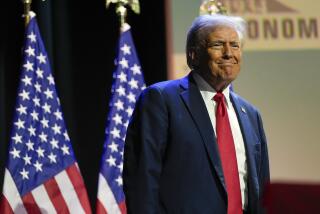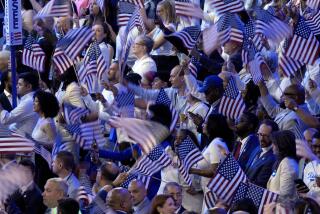Running Ads Up the Flagpole
With no less than President Bush and New York Mayor Rudolph W. Giuliani urging Americans to bolster the economy by traveling, shopping and dining out, Deepak Chhatwal figured it was his patriotic duty to drum up interest in his company’s pricey, handmade suits.
The Los Angeles clothing salesman sent an e-mail last month inviting several hundred upscale customers to enter a drawing for a free sports coat. It was his way of striking a small blow against terrorists seeking to “paralyze the U.S. economy,” he said in the electronic pitch.
Instead it was Chhatwal who got pummeled with a barrage of irate e-mails accusing him of cashing in on a national tragedy.
“I didn’t mean to offend anyone’s sensibilities,” said Chhatwal, Los Angeles sales representative for Tom James Co., who promptly e-mailed an apology. But “we live in a capitalistic economy.”
Commerce and patriotism are making for uneasy bedfellows in the weeks since the Sept. 11 terrorist attacks on New York and the Pentagon. From small operators with shoestring budgets like Chhatwal to large corporations with multimillion-dollar media campaigns, advertisers run the risk of alienating customers by using the red, white and blue in the pursuit of green.
There are no guarantees that these patriotic pitches will hit their marks, and some advertisers are keenly aware of the pitfalls.
Las Vegas tourism officials briefly considered sounding a patriotic note in their new television spots before concluding that such sentiments would sound too contrived, even for the playground of pretend.
Others are waving Old Glory with care. Kmart Corp. specifically avoided any mention of products in recent full-page print ads depicting the American flag, accompanied by the instructions: “Remove from newspaper. Place in window. Embrace Freedom.”
“With everything we’re doing, we ask ourselves if this can be viewed by someone as being opportunistic,” said Kmart spokesman Dave Karraker. “Whether it’s advertising, public relations, a community-giving campaign . . . we know you walk a fine line when you do something patriotic.”
Messages Cloaked in Old Glory
Still, companies peddling everything from beer to bedsheets are rushing to express condolences, celebrate American values or publicize their relief efforts.
Full-page newspaper advertisements for Polo Ralph Lauren’s newly established American Heroes Fund, for example, feature the fashion designer sporting an American flag-pattern sweater. Pen maker A.T. Cross is giving $5 to charity with every sale from a line of pens bearing an emblem of the American flag.
Under fat type reading “God Bless America” and “United We Stand,” Newport Beach-based Pacific Avalon Yacht Charters is running print ads touting its wedding packages.
Developer Shea Homes is plugging a Corona subdivision with newspaper ads featuring a photo collage of Old Glory and the Statue of Liberty urging consumers “to pursue the American Dream” and “get the economy moving again.”
While the creators of such ads might be well-meaning, their manipulation of what Cal State L.A. media psychology professor Stuart Fischoff describes as the “incestuous relationship between patriotism and capitalism” is creating real or perceived advertising missteps in a society where nerves are rubbed raw.
Advertising Age critic Bob Garfield, for example, has singled out General Motors Corp. for its highly publicized “Keep America Rolling” campaign, which blends unabashed patriotism--”let’s stand together and keep America rolling”--with pure commercialism--an unprecedented offer of free financing on the company’s automobiles.
“We have people in Afghanistan risking lives, 5,000 pulverized bodies in the smoldering rubble of the World Trade Center,” Garfield said. “How dare they suggest that the solution is to buy a damn truck. The whole thing is grotesque.”
GM contends its advertising was the right message at the right time.
“I’d take major exception if anyone suggests this was purely in [GM’s] self-interest,” said company spokesman Brian Akre. “ . . . It’s also good for our employees around the world. It has an impact on thousands of automotive suppliers. It’s good for our 7,000 dealers and it’s good for consumers, who are able to buy cars at a cheaper rate than any time in the past 20 years.”
Jon Albert, whose New York-based firm places songs and artists in commercials, also found himself on the defensive after using a mass e-mailing to alert ad agency executives that singer Lee Greenwood was willing to record “God Bless This Country” for an “appropriate” advertiser. The resulting backlash prompted Albert to send a second message expressing regret that “some parties felt Mr. Greenwood was trying to ‘exploit’ the tragedy.”
In an interview, Albert described the e-mail response generated by his message as “almost like talk radio. . . . I literally was shocked. I’m sure that there are always people out there who are going to be offended, no matter what you do.”
This isn’t the first time American advertisers have found themselves wrestling to stay relevant in the midst of tragedy, according to William M. O’Barr, a Duke University professor and editor of the online journal Advertising & Society Review.
During World War II, he said, American companies took to extolling patriotic virtues of conservation, saving and sacrifice--in part because there was little else to peddle with so much of America’s manufacturing capacity devoted to the war effort. When companies did talk about their products, it was often just to keep the brand alive in consumers’ minds.
“The classic example is ‘There’s a Ford in your future,’ ” O’Barr said. “There wasn’t much else they could say, since there weren’t any new cars to sell.”
Now, companies are faced with a very different dilemma: how to move consumer goods without appearing crass or insensitive.
Manufacturers of DVD players, cars, computers and home appliances face a glut of production capacity as consumers, even before Sept. 11, have reined in their spending. That’s a huge concern, considering consumer purchases of goods and services account for more than two-thirds of the gross national product.
Yet patriotic pitches that emphasize spending as a way to help America recover probably won’t persuade workers fearful of losing their jobs. And many consumers have already leveraged themselves to the limit. Credit card delinquencies had hit a 29-year high before the terrorist attacks.
It’s also unclear whether media-savvy Americans will respond to patriotic appeals like those issued during the “meatless, wheatless and heatless” days that marked life during World War II.
“We’re a country where constancy has been a given,” said Sergio Zyman, a former advertising chief for Coca-Cola Co. “We expect the newspaper on our doorstep at 5:30 a.m. and the news on TV at 7 a.m. But that expectation of constancy has been building for 50 years. During World War II, this was a very different country.”
Consumers Alert to ‘Plastic Patriotism’
History suggests that advertising with even a hint of self-promotion will turn off consumers, said David Lubars, president and executive creative director of the Minneapolis-based Fallon advertising agency, which creates ads for United Airlines and other major companies.
“Any patriotic message has got to be selfless,” Lubars said. Better to run a traditional spot with a familiar message, he says, “as opposed to attaching some transparent, plastic patriotism to it.”
Still, there is a feeling that advertisers cannot simply return to the over-the-top commercials of the late 1990s, characterized by such giddy ads as the one for a now-defunct dot-com firm that showed gerbils being shot out of a cannon.
“It’s a difficult time for them, trying to puzzle out what’s an acceptable commercial message right now,” said Jackson Lears, professor of cultural history at Rutgers University. “Everyone knows that blatant sex is inappropriate right now, but advertisers have been using it for so long that it’s hard to abandon it overnight.”
The Las Vegas Convention and Visitors Authority gave serious thought to incorporating a sober, patriotic theme into post-attack advertising for the desert getaway. Consumer interviews showed Vegas fans instead supported a straight-ahead ad promising the “freedom to escape from it all.”
Billy Vassiliadis, chief executive officer of R&R; Partners, the authority’s longtime ad agency, said: “Even some people in our own office were, frankly, a bit upset at how quickly we started moving to business as usual.”
Storyboards for the somber advertisement briefly considered by R&R; Partners showed white type on a black background that acknowledged the country’s shock, pain and grief. Soft music played as the spot gradually gave way to a hint of neon and, finally, a flash of Las Vegas’ trademark neon glitter.
But the commercial never ran. Interviews with visitors who traveled to Las Vegas in September, along with surveys in Los Angeles and other key markets, underscored that Vegas visitors view the city as an adult-oriented escape valve.
The new commercial now running in Los Angeles and other markets reflects that vision. The camera pulses from Vegas showgirls and entertainers Penn and Teller to bubbling fountains and swimming pools. Frank Sinatra croons that it’s time to “break out of that cage . . . and do all the things you’ve always wanted to do.”
Similarly, when round-the-clock coverage of the terrorist attacks finally gave way to football games, some consumers breathed a sigh of relief.
“I guess there is something reassuring about a familiar pitch to buy a car or a Coke,” said Duke University’s O’Barr.
Still, he predicts that advertisers will continue to wrestle with the emerging new American reality. On talk shows, in polls and interviews, Americans say the events of Sept. 11 have caused them to reexamine their priorities. Some say their new focus will be on how they live rather than what they buy.
“On the one hand, we’ve got leaders telling us to get back to business, act normal and spend money,” O’Barr said. “On the other, you’ve got fundamentalist groups like [Osama] Bin Laden’s saying America is a soulless nation where consumption and Coke and McDonald’s are what it’s all about. . . . Advertisers are caught in the middle.”
More to Read
Sign up for Essential California
The most important California stories and recommendations in your inbox every morning.
You may occasionally receive promotional content from the Los Angeles Times.










